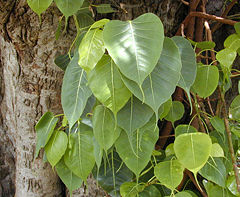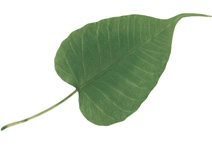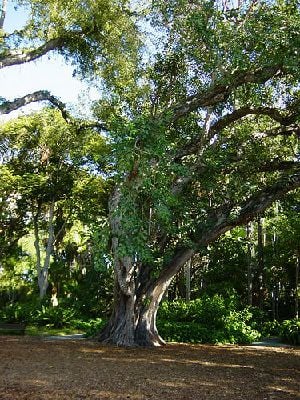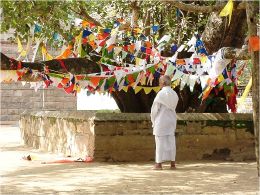Sacred fig
| Sacred Fig | ||||||||||||||
|---|---|---|---|---|---|---|---|---|---|---|---|---|---|---|
 Leaves and trunk of a Sacred Fig.
Note the distinctive leaf shape. | ||||||||||||||
| Scientific classification | ||||||||||||||
| ||||||||||||||
| Ficus religiosa L. |
Sacred fig (Ficus religiosa) is a species of banyan fig, characterized by great age and large size (up to 30 meters in height and a trunk diameter of up to 3 meters) and considered sacred by followers of Hinduism, Jainism, and Buddhism. Besides sacred fig, other common names include bo, Bodhi, peepul (or pipal), and the ashvastha tree.
Two famous representatives of sacred fig are the Bodhi tree and the Sri Maha Bodhi tree propagated from it. Siddhartha Gautama, the spiritual teacher and founder of Buddhism who later became known as Gautama Buddha, is referred to have been sitting underneath a sacred fig, known as the Bodhi tree, when he was enlightened (Bodhi), or "awakened" (Buddha). The known planting date of the Sri Maha Bodhi, 288 B.C.E., gives it the oldest verified age for any angiosperm ((flowering plant).
The sacred fig, or bo tree, is a well-known symbol for happiness, prosperity, longevity, and good luck. Today in India, Hindu Sadhus still meditate below this tree, and in Theravada Buddhist Southeast Asia, the tree's massive trunk is often the site of Buddhist and animist shrines.
Description
Ficus religiosa is a type of fig; that is, a member of the genus Ficus of the mulberry family, Moraceae. In addition to the sacred fig, other well known figs include the common fig, Ficus carica, which produces a commercially important multiple fruit, and banyan trees. The Ficus genus is characterized by hundreds of tiny flowers occurring in the inside of a fleshy, fruit-like body (a syconium). The fruit-like body or receptacle is commonly thought of as a fruit, but it is properly a false fruit or multiple fruit, in which the flowers and seeds grow together to form a single mass. Technically, a fig fruit would be one of many mature, seed-bearing flowers found inside one receptacle. The flowers of figs are pollinated by very small wasps known as fig wasps.
The sacred fig is a type of fig known as a banyan. While the term is often used specifically for the species Ficus benghalensis, in the broader sense of the term used here a banyan is a type of fig that starts its life as an epiphyte when its seeds germinate in the cracks and crevices on a host tree (or on structures like buildings and bridges). Figs that share a similar unique life cycle are given the generalize term "banyans" and placed together in the subgenus Urostigma. The seeds of banyans are dispersed by fruit-eating birds. The seeds germinate and send down roots towards the ground, and may envelope part of the host tree or building structure with their roots, giving them the casual name of "strangler fig". Older banyan trees are characterized by their aerial prop roots, which grow into thick woody trunks which, with age, can become indistinguishable from the main trunk. Old trees can spread out laterally using these prop roots to cover a wide area.
Ficus religiosa, the sacred fig, is large dry season-deciduous or semi-evergreen tree. The leaves are cordate in shape with a distinctive extended tip; they are 10-17 centimeters long and 8-12 centimeters broad, with a 6-10 centimeter petiole. The fruit is a small fig 1-1.5 centimeters in diameter, green ripening purple. The trees are up to 30 meters tall and with a trunk diameter of up to 3 m.
The sacred fig is native to Sri Lanka, Nepal, and India, southwest China, and Indochina east to Vietnam. The wide range of local names include bo or pou (from the Sinhalese bo), Bodhi (in Thai Language), pipal (peepal, peepul, pippala, pimpal, etc.), arali, or Ashvastha tree.
Bodhi tree
The Bodhi Tree, also known as Bo (from the Sinhalese Bo), was a large and very old Sacred Fig tree, located in Bodh Gaya (about 100 km/62 mi from Patna in the Indian state of Bihar) under which Siddhartha Gautama, the spiritual teacher and founder of Buddhism later known as Gautama Buddha, achieved enlightenment, or Bodhi. In religious iconography, the Bodhi tree is easily recognizable from its heart-shaped leaves, which are usually prominently displayed. It is of the species sacred fig (ficus religiosa).
The term "Bodhi tree" is also widely applied to currently existing trees, particularly the Sacred Fig growing at the Mahabodhi Temple, which is probably a direct descendant of the original specimen. This tree is a frequent destination for pilgrims, being the most important of the four holy sites for Buddhists. Other holy Bodhi trees which have a great significance in the history of Buddhism are the Anandabodhi tree in Sravasti and the Bodhi tree in Anuradhapura. Both are believed to have been propagated from the original Bodhi tree.
In Buddhist chronology
The Bodhi tree at the Mahabodhi Temple is called the Sri MahaBodhi. According to Buddhism, after his Enlightenment, the Buddha spent a whole week in front of the tree, standing with unblinking eyes, gazing at it with gratitude. A shrine was later erected on the spot where he so stood, and was called the Animisalocana cetiya (q.v.).
The spot was used as a shrine even in the lifetime of the Buddha, the only shrine that could be so used. King Asoka was most diligent in paying homage to the Bodhi tree, and held a festival every year in its honour in the month of Kattika.[1] His queen, Tissarakkhā was jealous of the Tree, and three years after she became queen (i.e., in the nineteenth year of Asoka's reign), she caused the tree to be killed by means of mandu thorns.[2] The tree, however, grew again, and a great monastery was attached to the Bodhimanda called the Bodhimanda Vihara. Among those present at the foundation of the Mahā Thūpa are mentioned thirty thousand monks from the Bodhimanda Vihara, led by Cittagutta.[3]
To Jetavana, Sravasti
Buddhist tradition recounts that while the Buddha was yet alive, in order that people might make their offerings in the name of the Buddha when he was away on pilgrimage, he sanctioned the planting of a seed from the Bodhi tree in Bodhgaya in front of the gateway of Jetavana Monastery near Sravasti. For this purpose Moggallana took a fruit from the tree as it dropped from its stalk, before it reached the ground. It was planted in a golden jar by Anathapindika with great pomp and ceremony. A sapling immediately sprouted forth, fifty cubits high, and in order to consecrate it the Buddha spent one night under it, rapt in meditation. This tree, because it was planted under the direction of Ananda, came to be known as the Ananda Bodhi.[4]
To Anuradhapura, Sri Lanka
According to the Ceylon Chronicles, the Sri Maha Bodhi in Sri Lanka was planted in 288 B.C.E., making it the oldest verified specimen of any angiosperm. In this year (the twelfth year of King Asoka's reign) the right branch of the Bodhi tree was brought by Sanghamittā to Anurādhapura and placed by Devānāmpiyatissa in the Mahāmeghavana. The Buddha, on his death bed, had resolved five things, one being that the branch which should be taken to Ceylon should detach itself (Mhv.xvii.46f). From Gayā, the branch was taken to Pātaliputta, thence to Tāmalittī, where it was placed in a ship and taken to Jambukola, across the sea; finally it arrived at Anuradhapura, staying on the way at Tivakka. Those who assisted the king at the ceremony of the planting of the Tree were the nobles of Kājaragāma and of Candanagāma and of Tivakka.
The trees of Previous Buddhas
According to the Ceylon Chronicles (e.g., Mhv.xv), branches from the Bodhi trees of all the Buddhas born during this kalpa were planted in Ceylon on the spot where the sacred Bodhi tree stands today in Anurādhapura. The branch of Kakusandha's tree was brought by a nun called Rucānandā, Konagamana's by Kantakānandā (or Kanakadattā), and Kassapa's by Sudhammā.
Sri Maha Bodhi
|-
|
|} Sri Maha Bodhi is a Sacred Fig tree in Anuradhapura, Sri Lanka. It is said to be a sapling from the historical Bodhi tree under which Buddha became enlightened. It was planted in 288 B.C.E., and is the oldest living human-planted tree in the world with a known planting date.
It was planted on a high terrace about 6.5 m (21.3 ft) above the ground and surrounded by railings, and today it is one of the most sacred relics of the Buddhists in Sri Lanka and respected by Buddhists all over the world. This wall was constructed during the reign of King Kirthi Sri Rajasingha, to protect it from wild elephants which might have damaged the tree.
History
The tree is said to be the southern branch of the Jaya Siri Maha Bodhi at Bodh Gaya in India under which Buddha attained Enlightenment.
In the 3rd century B.C.E., the Buddha's fig tree was brought to Sri Lanka by the Their Sangamitta (Pali; Skt.: Sanghamitra), daughter of Emperor Asoka and founder of an order of Buddhist nuns in Sri Lanka.
In 249 B.C.E., Jaya Siri Maha Bodhi was planted in the Mahameghavana Park in Anuradhapura by King Devanampiyatissa.
Plaksa
Plaksa is a possible Sanskrit term for the Sacred fig. According to Macdonell and Keith (1912), it rather denotes the Wavy-leaved Fig tree (Ficus infectoria).
In Hindu texts, the Plaksa tree is associated with the source of the Sarasvati River. The Skanda Purana states that the Sarasvati originates from the water pot of Brahma and flows from Plaksa on the Himalayas. According to Vamana Purana 32.1-4, the Sarasvati was rising from the Plaksa tree (Pipal tree).[5]
Plaksa Pra-sravana denotes the place where the Sarasvati appears.[6] In the Rigveda Sutras, Plaksa Pra-sravana refers to the source of the Sarasvati.[7]
Notes
- ↑ Mhv.xvii.17
- ↑ Mhv.xx.4f
- ↑ Mhv.xxix.41
- ↑ J.iv.228ff
- ↑ D.S. Chauhan in Radhakrishna, B.P. and Merh, S.S. (editors): Vedic Sarasvati, 1999, p.35-44
- ↑ Pancavimsa Brahmana, Jaiminiya Upanisad Brahmana, Katyayana Srauta Sutra, Latyayana Srauta; Macdonell and Keith 1912
- ↑ Asvalayana Srauta Sutra, Sankhayana Srauta Sutra; Macdonell and Keith 1912, II:55
See also
- Sri Maha Bodhi
- Sitala
ReferencesISBN links support NWE through referral fees
- Keith and Macdonell. 1912. Vedic Index of Names and Subjects.
- Plaksa description
"Trees with a Difference: The Strangler Figs"|61.0 KiB}} by Vidya R Athreya, Nature Watch, July 1997; also "Aerial-rooting banyan trees", washington.edu</ref>
External links
Credits
New World Encyclopedia writers and editors rewrote and completed the Wikipedia article in accordance with New World Encyclopedia standards. This article abides by terms of the Creative Commons CC-by-sa 3.0 License (CC-by-sa), which may be used and disseminated with proper attribution. Credit is due under the terms of this license that can reference both the New World Encyclopedia contributors and the selfless volunteer contributors of the Wikimedia Foundation. To cite this article click here for a list of acceptable citing formats.The history of earlier contributions by wikipedians is accessible to researchers here:
The history of this article since it was imported to New World Encyclopedia:
Note: Some restrictions may apply to use of individual images which are separately licensed.




